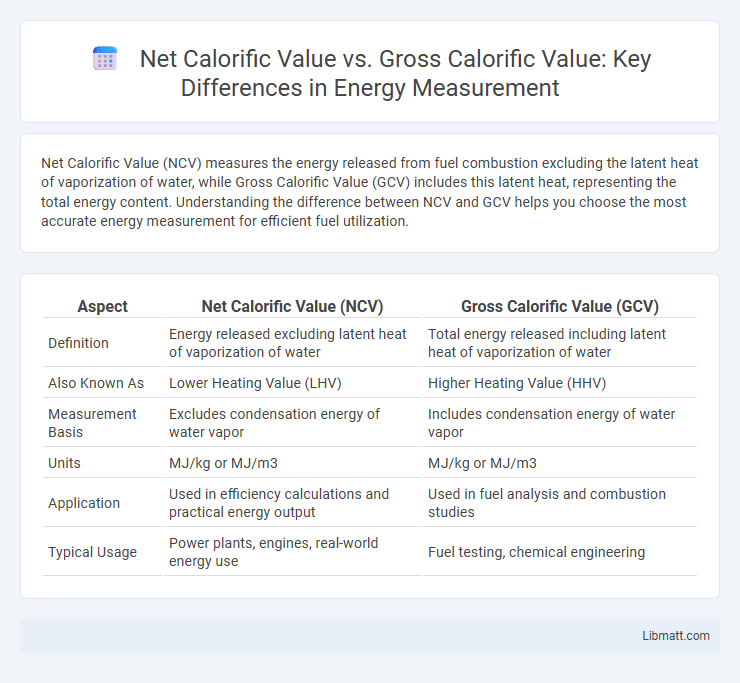Net Calorific Value (NCV) measures the energy released from fuel combustion excluding the latent heat of vaporization of water, while Gross Calorific Value (GCV) includes this latent heat, representing the total energy content. Understanding the difference between NCV and GCV helps you choose the most accurate energy measurement for efficient fuel utilization.
Table of Comparison
| Aspect | Net Calorific Value (NCV) | Gross Calorific Value (GCV) |
|---|---|---|
| Definition | Energy released excluding latent heat of vaporization of water | Total energy released including latent heat of vaporization of water |
| Also Known As | Lower Heating Value (LHV) | Higher Heating Value (HHV) |
| Measurement Basis | Excludes condensation energy of water vapor | Includes condensation energy of water vapor |
| Units | MJ/kg or MJ/m3 | MJ/kg or MJ/m3 |
| Application | Used in efficiency calculations and practical energy output | Used in fuel analysis and combustion studies |
| Typical Usage | Power plants, engines, real-world energy use | Fuel testing, chemical engineering |
Understanding Calorific Value: An Overview
Calorific value measures the energy released during fuel combustion, with Net Calorific Value (NCV) excluding the latent heat of vaporization of water, while Gross Calorific Value (GCV) includes it. NCV is crucial for assessing actual usable energy in applications where water vapor condenses, impacting efficiency calculations. Your understanding of these values ensures accurate energy content evaluation for fuels in both industrial and residential contexts.
What is Net Calorific Value (NCV)?
Net Calorific Value (NCV) refers to the amount of heat released by the combustion of a fuel, excluding the latent heat of vaporization of water content in the combustion products. It represents the actual usable energy available from the fuel for practical applications. Your choice between NCV and Gross Calorific Value depends on whether you need the heat energy excluding or including water vapor condensation.
What is Gross Calorific Value (GCV)?
Gross Calorific Value (GCV) is the total amount of heat released when a fuel is completely burned, including the latent heat of vaporization of water in the combustion products. It measures the maximum potential energy content of the fuel without subtracting energy lost as water vapor. Understanding GCV helps you evaluate the overall energy efficiency and is critical for designing combustion systems and energy conversion processes.
Key Differences Between NCV and GCV
Net Calorific Value (NCV) measures the available energy from fuel excluding the latent heat of vaporization of water, whereas Gross Calorific Value (GCV) includes this latent heat, representing the total energy released during combustion. NCV is typically lower than GCV because it subtracts the energy lost as water vapor heat, making NCV crucial for practical energy efficiency assessments in power plants and engines. Understanding the distinction between NCV and GCV is essential for accurate fuel analysis, combustion optimization, and emissions calculations.
Calculation Methods for Calorific Values
Net Calorific Value (NCV) is calculated by measuring the total heat released during complete combustion minus the latent heat of vaporization of water in the combustion products, reflecting the usable energy available. Gross Calorific Value (GCV), also known as Higher Heating Value (HHV), is determined by measuring the total heat released during combustion, including the condensation heat of water vapor generated. Standard methods for these calculations often involve bomb calorimetry, where the sample is burned in a controlled environment, and the heat released is precisely measured to derive both NCV and GCV.
Importance of Calorific Value in Energy Industries
Calorific value represents the amount of energy released during fuel combustion, making it crucial for efficiency assessments in energy industries. Net Calorific Value (NCV) excludes the latent heat of vaporization of water, while Gross Calorific Value (GCV) includes it, directly influencing fuel selection and boiler design. Understanding these values helps you optimize fuel usage, reduce operational costs, and minimize environmental impact in power generation and industrial processes.
Practical Applications of NCV and GCV
Net Calorific Value (NCV) and Gross Calorific Value (GCV) are crucial in energy industries for designing efficient combustion systems and optimizing fuel usage. NCV is preferred in practical applications like power plants and engines because it excludes latent heat from water vapor, providing a realistic measure of the usable energy. Your energy cost calculations and emission assessments depend heavily on accurate NCV and GCV values to ensure optimal performance and regulatory compliance.
Factors Affecting Calorific Values
Factors affecting net calorific value (NCV) and gross calorific value (GCV) include fuel composition, moisture content, and combustion conditions. Higher moisture content reduces the NCV because energy is consumed in evaporating water, while the GCV accounts for the total heat released including latent heat of vaporization. Understanding these factors helps you optimize fuel efficiency and select the best fuel for your energy needs.
Measurement Standards and Units
Net Calorific Value (NCV) and Gross Calorific Value (GCV) are measured based on standardized protocols such as ISO 1928 and ASTM D2015 to ensure accuracy and consistency in evaluating fuel energy content. GCV represents the total energy released during combustion including the latent heat of vaporization of water, while NCV subtracts this latent heat, reflecting usable energy. Both values are typically expressed in units of megajoules per kilogram (MJ/kg) or British thermal units per pound (BTU/lb), key metrics for energy analysis in industries like power generation and fuel manufacturing.
NCV vs GCV: Choosing the Right Value for Your Needs
Net Calorific Value (NCV) and Gross Calorific Value (GCV) are essential metrics for assessing fuel energy content, with GCV measuring total energy including latent heat of vaporization and NCV excluding it, reflecting usable energy. Selecting the right value depends on your application; industrial processes requiring precise combustion efficiency often rely on NCV, while GCV suits theoretical energy yield calculations. Understanding these differences ensures optimal fuel selection and accurate energy cost analysis for your operations.
Net Calorific Value vs Gross Calorific Value Infographic

 libmatt.com
libmatt.com